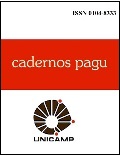Abstract
This paper is based on research, funded by CNPq, which examines the perceptions and experiences of female professors and students about gender relations in academic life in traditionally masculine fields, with a focus on physics. The research field is a federal university in Brazil’s Northeast and the methodological procedures involved interviews, after mapping the distribution of professors and students by sex. The results show women’s difficulties, as professors and students, in being included in the field.
References
ACKER, Sandra; ARMENTIB, Carmen. Sleepless in academia. Gender and Education, v. 16, Issue 1, 2004, pp.3-24 Disponível em: https://doi.org/10.1080/0954025032000170309. Acesso em: Jul.17 2015.
AGRELLO, Deise A.; GARG, Reva. Mulheres na física: poder e preconceito nos países em desenvolvimento. Revista Brasileira Ensino Física, v. 31, n.1, São Paulo, 2009, pp.1305.1-1305.6. Disponível em: https://www.scielo.br/pdf/rbef/v31n1/v31n1a05.pdf. Acesso em: Jul.17 2015].
ANDRADE, Sandra dos S. A entrevista narrativa ressignificada nas pesquisas educacionais pós-estruturalistas. In: MEYER, Dagmar E.; PARAÍSO, Marlucy A. (Org). Metodologias de pesquisas pós-críticas em Educação Belo Horizonte, Mazza Edições, 2012, pp.173-194.
AMORIM, Valquiria Gila de. Gênero e Educação Superior: Perspectivas de Alunas de Física. Dissertação (Mestrado em Educação), Universidade Federal da Paraíba, 2017.
BARTHELEMY, Ramón S.; MCCORMICK, Melinda; HENDERSON, Charles. Gender discrimination in physics and astronomy: Graduate student experiences of sexism and gender microaggressions. American Physics Society, Ridge, NY, 2016. Disponível em: https://journals.aps.org/prper/abstract/10.1103/PhysRevPhysEducRes.12.020119. Acesso em: 17. jun. 2017.
BLICKENSTAFF, Jacob Clark. Women and science careers: leaky pipeline or gender filter? Gender and Education, v. 17, Issue 4, 2005, pp.369-386. Disponível em: https://www.tandfonline.com/doi/abs/10.1080/09540250500145072. Acesso em: 17. jul. 2015.
BOURDIEU, Pierre. A Dominação Masculina Rio de Janeiro, Bertrand Brasil, 1999.
BURGER, Carol et alii. Gender equity in science, engineering, and technology. In: KLEIN, S. S. (gen. ed.). Handbook for Achieving Gender Equity Through Education 2. ed. New York and London, Routledge, 2010, pp.255-279.
CARVALHO, Maria Eulina P. de. Relações de gênero em cursos masculinos: engenharias mecânica e civil, física, matemática e ciência da computação Relatório de Pesquisa, Projeto 471892/2014-9, Chamada MCTI/CNPQ/MEC/CAPES nº 22/2014 - Ciências Humanas e Sociais. João Pessoa, Universidade Federal da Paraíba, 2017.
CARVALHO, Maria Eulina P. de. Relações de gênero na universidade: carreiras docentes e perspectivas profissionais discentes Relatório de Pesquisa. Processo 401013/2010-3, Edital MCT/CNPq/MEC/CAPES nº 02/2010 - Ciências Humanas, Sociais e Sociais Aplicadas. João Pessoa, Universidade Federal da Paraíba, 2012.
COOPER, Joanne et alii. Improving gender equity in post secondary education. In: KLEIN, S. S. (gen. ed.). Handbook for Achieving Gender Equity through Education, 2. ed., New York and London, Routledge, 2010, pp.631-653.
DANIELSSON, Anna T. Exploring woman university physics students “doing gender” and “doing physics”. Gender and Education v 24, n. 1, January, 2012, pp.25-39. Disponível em: https://www.tandfonline.com/doi/abs/10.1080/09540253.2011.565040. Acesso em: 17. jul. 2015.
DONOSO-VAZQUEZ, Trinidad; GAZO, Pilar. F.; MORENO, Maria Luisa R. Factores discriminatorios en función del género en la carrera profesional de las mujeres. In: MONTANÉ, A; CARVALHO, M. E. P. de (coord.). Mujeres y Educación Superior João Pessoa, Editora da UFPB, 2013, pp.55-74.
HILL, Catherine, CORBETT, Christianne; ST. ROSE, Andresse. Why so few? Women in Science, Technology, Engineering, and Mathematics AAUW, Washington DC, 2010. Disponível em: https://ww3.aauw.org/research/why-so-few/. Acesso em: 17. Jul. 2015.
KELCHTERMANS, Geert. Biographical methods in the study of teachers' professional development. In: CALGREN, Ingrid; HANDAL, Gunnar; VAAGE, Sveinung (Ed.). Teacher thinking in action in varied contexts: research on teachers’ thinking and practice London, Falmer Press, 1994, pp.93-108.
LACAMPAGNE, Carole. B. et alii. Gender equity in mathematics. In: KLEIN, S. S. (gen. ed.). Handbook for Achieving Gender Equity Through Education 2. ed. New York and London, Routledge, 2010, pp.235-253.
LEONARD, Diana. A woman’s guide to doctoral studies Maidenhead, Open University Press, 2001.
LIMA, Nádia R. L. B. Quando as meninas não contam: gênero e ensino da matemática. Maceió, Viva Editora, 2013.
LOMBARDI, Maria Rosa (Coord.). “Por que são tão poucas?”: um estado da arte dos estudos em “Engenharia e gênero”. Textos Fundação Carlos Chagas, Relatórios Técnicos (49), São Paulo, 2016, pp.1-48.
ÖHRN, Elisabet et alii. Gender and career in academia. Paper presented at the NERA Congress in Trondheim, Norway, March 5-7, 2009.
REES, Teresa. Mainstreaming Gender Equality in Science in the European Union: The “ETAN Report”. Gender and Education, v. 13, Issue 3, 2001, pp.243-260. Disponível em: https://www.tandfonline.com/doi/abs/10.1080/09540250120063544. Acesso em: 17. jul. 2015.
ROGER, Angela; DUFFIELD, Jill. Factors Underlying Persistent Gendered Option Choices in School Science and Technology in Scotland. Gender and Education, v. 12, Issue 3, 2000, pp.367-383. Disponível em: [https://www.tandfonline.com/doi/abs/10.1080/713668300. Acesso em: 17 jul. 2015.
ROSA, Katemari D. da. Gender, Ethnicity, and Physics Education: Understanding How Black Women Build Their Identities as Scientists Doctoral Dissertation, Science Education, Columbia University, 2013.
SANDLER, Bernice R. The Chilly Climate National Association for Women in Education, 2005. Disponível em: https://sun.iwu.edu/~mgardner/Articles/chillyclimate.pdf. Acesso em: 21 nov. 2015.
SARRIÓ, Maite et alii. El techo de cristal en la promoción profesional de las mujeres. Revista de Psicología Social, 17(2), 2002, pp.167-182. Disponível em: https://www.tandfonline.com/doi/abs/10.1174/021347402320007582. Acesso em: 17 jul. 2015.
SCHIEBINGER, Londa. O feminismo mudou a ciência? Bauru, EDUSC, 2001.
SHAKESHAFT, Charol et alii. Increasing gender equity in educational leadership. In: KLEIN, Susan S. (gen. ed.), Handbook for Achieving Gender Equity through Education, 2nd ed., New York and London, Routledge, 2010, pp.103-129.
SKIBBA, Ramin. Women in physics face big hurdles — still persistent biases continue to affect the numbers of female physicists. Natura/News, 2016. Disponível em: http://www.nature.com/news/women-in-physics-face-big-hurdles-still-1.20349. Acesso em: 20 jun. 2016.
SILVA, Lucimeiry Batista da. Carreiras de professoras das Ciências Exatas e Engenharia: estudo em uma IFES do Nordeste brasileiro. Tese (Doutorado em Educação), Universidade Federal da Paraíba, 2017.
STEPULEVAGE, Linda. Gender/Technology Relations: Complicating the gender binary. Gender and Education, v. 13, Issue 3, 2001, pp.325-338. Disponível em: https://www.tandfonline.com/doi/abs/10.1080/09540250120082525. Acesso em: 17 jul. 2015.
WARRINGTON, Molly; YOUNGER, Michael. The Other Side of the Gender Gap. Gender and Education, v. 12, Issue 4, 2000, pp.493-508. Disponível em: https://www.tandfonline.com/doi/abs/10.1080/09540250020004126. Acesso em: 17 jul. 2015.

This work is licensed under a Creative Commons Attribution 4.0 International License.
Copyright (c) 2021 xxxxx


